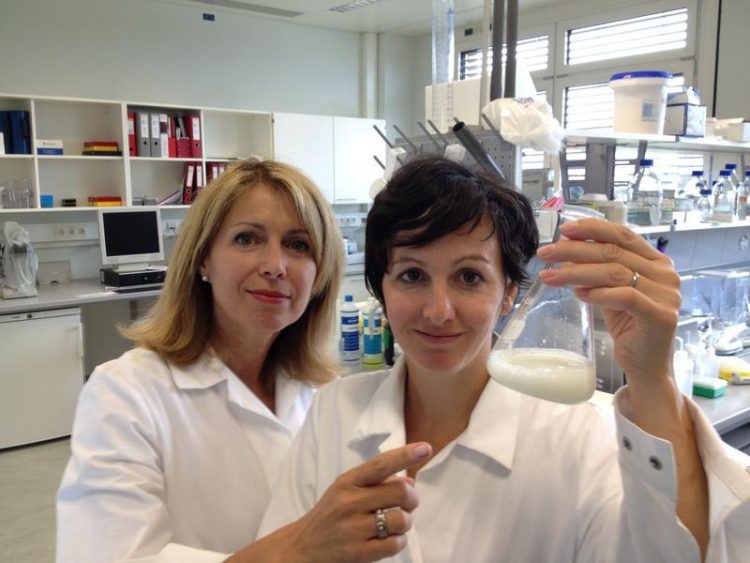Scientists uncover why major cow milk allergen is actually allergenic

Erika Jensen-Jarolim and Franziska Roth-Walter decipher the mechanisms of allergic reactions. Photo: Erika Jensen-Jarolim/Vetmeduni Vienna
Scientists at Messerli Research Institute at the Vetmeduni Vienna, the Medical University of Vienna, and the University of Vienna investigated what actually makes the milk allergenic. A specific protein in milk known as beta-lactoglobulin is able to initiate an allergy only when being devoid of iron.
Loaded with iron, the protein is harmless. The scientists discovered the same mechanism recently with regard to birch pollen allergy. Their findings help to decipher allergic reactions and were published in the journal PLOS ONE.
Milk allergy is frequently confused with lactose intolerance. However, these are two entirely different mechanisms that occur in the body. People with lactose intolerance do not digest lactose properly because they lack an enzyme known as lactase. In the case of the potentially much more dangerous cow milk allergy, however, the body's immune system attacks milk proteins with its own IgE antibodies.
According to statistics, about two to three percent of children in Europe suffer from a genuine milk allergy. Less adults are diagnosed with the disease. The formation of so-called Th2 lymphocytes is initiated in these patients. Th2 lymphocytes contribute in great measure to the production of IgE antibodies to milk proteins. Hence, people develop an allergic reaction to milk.
Such an allergy may cause swelling of the mouth and mucous membranes, diarrhea, exacerbation of neurodermitis, and in rare cases even an allergic shock. Precise diagnostic investigation helps to differentiate between allergy and intolerance and thus avoid incorrect diets which, under certain circumstances, may cause malnutrition.
Lack of iron load transforms milk protein into allergen
One of the most important milk allergens, the so-called beta-lactoglobulin, belongs to the protein family of lipocalins. Lipocalins possess molecular pockets which are able to accommodate iron complexes. Iron is bound to the protein by so-called siderophores. The first author Franziska Roth-Walter and her colleagues now show that an “empty” milk protein, one without iron and siderophores, helps to activate Th2 lymphocytes. As a consequence, the production of IgE antibodies against the milk protein is stimulated. The patient gets sensitized and may develop an allergic reaction to milk. Roth-Walter, working at the department of Comparative Medicine at the Messerli Research Institute says: “Knowledge of the molecular structure of allergens has contributed very significantly to our conclusion about milk allergy. This is of enormous practical relevance.”
Investigating the difference between organic and conventional milk
As the next step the scientists want to find out, what contributes to the iron load of milk proteins. The lead investigator Erika Jensen-Jarolim explains: “One of the most burning questions we want to answer is: Why are these milk proteins loaded to a greater or lesser extent with iron? The manner of keeping and feeding cows may be a factor involved in this phenomenon. Iron loading may depend on whether the milk is produced organically or conventionally. This will be one of our major interests in the future. Lipocalins exist in all mammals. We assume that our conclusions will be applicable to the milk of other mammals as well.”
Service:
The article „The major cow milk allergen Bos d 5 manipulates T-helper cells depending on its load with siderophore-bound iron”, by Franziska Roth-Walter, Luis. F. Pacios, Cristina Gomez-Casado, Gerlinde Hofstetter, Georg A. Roth, Josef Singer, Araceli Diaz-Perales and Erika Jensen-Jarolim was published on the 12th of August in the journal PLOS ONE. DOI: 10.1371/journal.pone.0104803
http://www.plosone.org/article/info%3Adoi%2F10.1371%2Fjournal.pone.0104803
About the Messerli Research Institute
The Messerli Research Institute was founded in 2010 with support from the Messerli Foundation (Sörenberg, Switzerland) under the management of the University of Veterinary Medicine, Vienna in cooperation with the Medical University of Vienna and the University of Vienna. Its research is devoted to the interaction between humans and animals, as well as its theoretical principles in animal cognition and behavior, comparative medicine and ethics. http://www.vetmeduni.ac.at/messerli
About the University of Veterinary Medicine, Vienna
The University of Veterinary Medicine, Vienna in Austria is one of the leading academic and research institutions in the field of Veterinary Sciences in Europe. About 1,200 employees and 2,300 students work on the campus in the north of Vienna which also houses five university clinics and various research sites. Outside of Vienna the university operates Teaching and Research Farms. http://www.vetmeduni.ac.at
Scientific Contact:
Prof. Erika Jensen-Jarolim
Comparative Medicine
Messerli Research Institute
University of Veterinary Medicine Vienna
Medical University Vienna
erika.jensen-jarolim@vetmeduni.ac.at
Released by:
Susanna Kautschitsch
Science Communication / Public Relations
University of Veterinary Medicine Vienna (Vetmeduni Vienna)
T +43 1 25077-1153
susanna.kautschitsch@vetmeduni.ac.at
http://www.vetmeduni.ac.at/en/infoservice/presseinformation/press-releases-2014/…
Media Contact
All latest news from the category: Life Sciences and Chemistry
Articles and reports from the Life Sciences and chemistry area deal with applied and basic research into modern biology, chemistry and human medicine.
Valuable information can be found on a range of life sciences fields including bacteriology, biochemistry, bionics, bioinformatics, biophysics, biotechnology, genetics, geobotany, human biology, marine biology, microbiology, molecular biology, cellular biology, zoology, bioinorganic chemistry, microchemistry and environmental chemistry.
Newest articles

Innovative 3D printed scaffolds offer new hope for bone healing
Researchers at the Institute for Bioengineering of Catalonia have developed novel 3D printed PLA-CaP scaffolds that promote blood vessel formation, ensuring better healing and regeneration of bone tissue. Bone is…

The surprising role of gut infection in Alzheimer’s disease
ASU- and Banner Alzheimer’s Institute-led study implicates link between a common virus and the disease, which travels from the gut to the brain and may be a target for antiviral…

Molecular gardening: New enzymes discovered for protein modification pruning
How deubiquitinases USP53 and USP54 cleave long polyubiquitin chains and how the former is linked to liver disease in children. Deubiquitinases (DUBs) are enzymes used by cells to trim protein…



